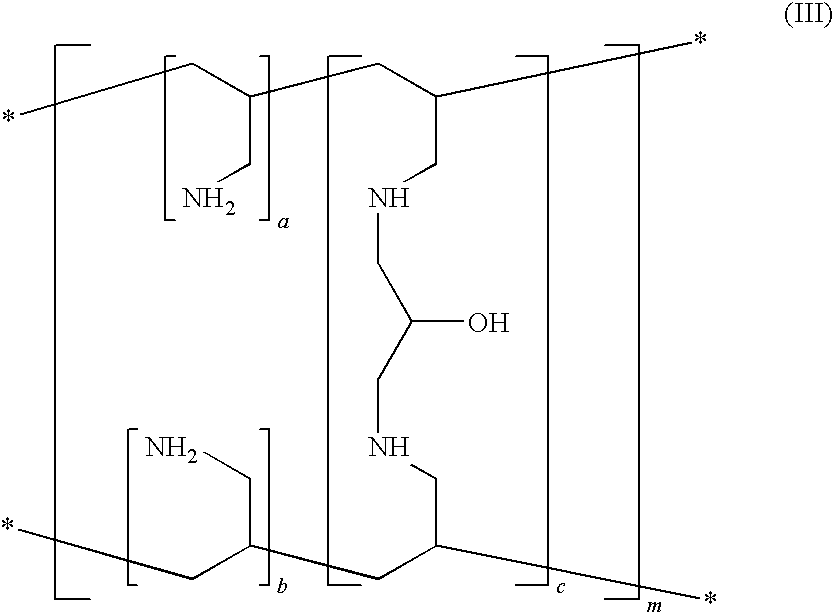One step process for preparing cross-linked poly(allylamine) polymers
a technology of allylamine and polymer, which is applied in the direction of capsule delivery, organic active ingredients, metabolic disorder, etc., can solve the problems of aluminium accumulation, dialysis and reduced dietary phosphate, severe abnormalities in calcium and phosphorus metabolism, etc., to improve the chemical homogeneity of the final product, improve the effect of reducing energy consumption and reducing the number of unreacted monomers
- Summary
- Abstract
- Description
- Claims
- Application Information
AI Technical Summary
Benefits of technology
Problems solved by technology
Method used
Image
Examples
example 1
Preparation of 1,3-bis-allylamino-2-propanol (IV), dihydrochloride salt
[0159]A 1 L four-necked flask, equipped with a mechanical stirrer, temperature probe, dropping funnel and a condenser topped with a nitrogen gas inlet, was charged with allylamine (321 g, 5.62 mol) and water (46 mL). The resulting mixture was heated to 57° C. and, while maintaining a vigorous stirring, a solution of glycidyl tosylate (Va) (128 g, 0.561 mol) in THF (128 mL) was added dropwise. When the addition of (Va) was complete, the reaction was allowed to stir at 62° C. for 45 minutes. The reaction progress and / or completion was monitored by TLC for the disappearance of (Va) (eluent: n-hexane / ethyl acetate 7:3 volume / volume). The reaction mixture was concentrated to residue under reduced pressure, isopropanol (700 mL) was added and the pH of the solution was adjusted to 1-1.5 by adding aqueous hydrochloric acid (37%, 148 mL). While stirring, the mixture was cooled to 5° C., and the solid was filtered and wash...
example 2
Preparation of Sevelamer Hydrochloride (III)
Method A
[0164]A 250 mL jacketed reaction vessel, equipped with a mechanical stirrer, temperature probe, dropping funnel and a condenser topped with a nitrogen gas inlet, was charged with 37% hydrochloric acid (27.6 g, 0.280 mol), and the solution was cooled to 0° C. Allylamine (16 g, 0.280 mol) was added dropwise while stirring, maintaining the temperature from 5 to 10° C. After the addition was complete, acetonitrile (52.2 mL) and 1,3-bis-allylamino-2-propanol dihydrochloride (IV) (8.3 g, 0.034 mol) were added. The solution was heated to 50° C. and the azo-initiator VA-044 (1.15 g) was added. The reaction was allowed to stir at 50° C. for 24 hours. VA-044 (1.15 g) was added again and the heating and stirring was continued for additional 18 hours. Then the solid was filtered off, washed with methanol (150 mL) and dried under reduced pressure at 40° C. to afford a granular, pale-yellow solid (27 g), with a phosphate binding capacity of 13.6...
example 3
Preparation of Sevelamer Hydrochloride (III)
Method A
[0165]A 250 mL jacketed reaction vessel, equipped with a mechanical stirrer, temperature probe, dropping funnel and a condenser topped with a nitrogen gas inlet, was charged with 37% hydrochloric acid (55.3 g, 0.561 mol), and the solution was cooled to 0° C. Allylamine (32 g, 0.561 mol) was added dropwise while stirring, maintaining the temperature from 5 to 10° C. After the addition was complete, the liquid (12 ml) was removed by distillation under reduced pressure at 60-70° C. The solution was cooled to 50° C., 1,3-bis-allylamino-2-propanol dihydrochloride (IV) (16 g, 0.067 mol) and the azo-initiator VA-044 (1.15 g), suspended in water (2.5 mL), were added. The reaction was allowed to stir at 50° C. for 24 hours. VA-044 (1.15 g) suspended in water (2.5 mL) was added again and the heating and stirring was continued for additional 18 hours. The reaction mixture was added with methanol (1 L), and the solid was filtered and suspended...
PUM
| Property | Measurement | Unit |
|---|---|---|
| size | aaaaa | aaaaa |
| size | aaaaa | aaaaa |
| size | aaaaa | aaaaa |
Abstract
Description
Claims
Application Information
 Login to View More
Login to View More - R&D
- Intellectual Property
- Life Sciences
- Materials
- Tech Scout
- Unparalleled Data Quality
- Higher Quality Content
- 60% Fewer Hallucinations
Browse by: Latest US Patents, China's latest patents, Technical Efficacy Thesaurus, Application Domain, Technology Topic, Popular Technical Reports.
© 2025 PatSnap. All rights reserved.Legal|Privacy policy|Modern Slavery Act Transparency Statement|Sitemap|About US| Contact US: help@patsnap.com



